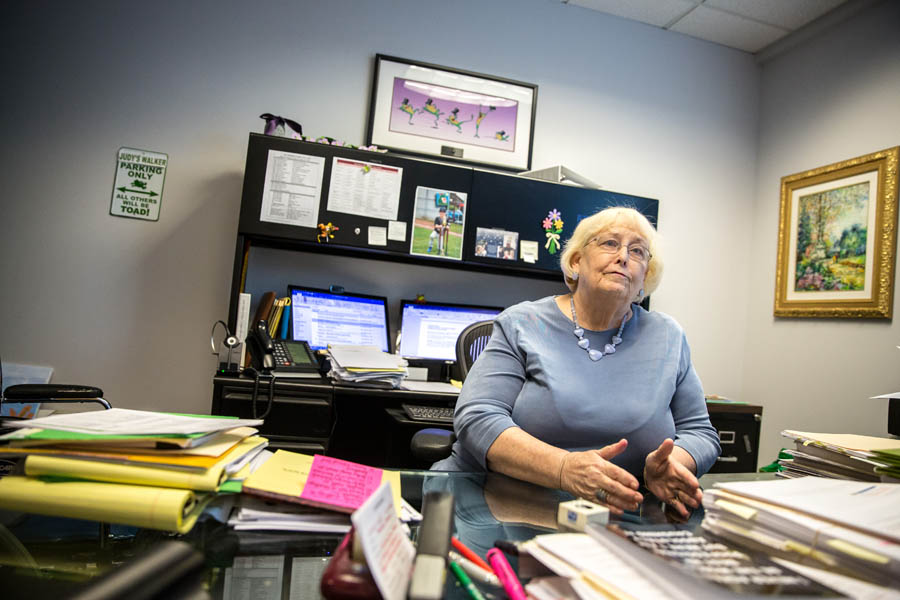Companies recalibrate their HR departments in the wake of #MeToo.
It’s been a tough year for Nike.
Their well-documented #MeToo controversy started with a secret questionnaire circulated by female employees fed up with what they saw as a toxic workplace culture that advanced men, undervalued women and ignored widespread sexual harassment. It ended with the ousting of 11 male senior managers, two sweeping lawsuits and one big black eye to the Beaverton footwear and apparel giant’s reputation.
The company’s human resources department took a particularly hard hit. Women working at Nike developed a “deep skepticism” of HR according to a New York Times investigation. Some avoided the department altogether, fearing retribution or convinced that nothing would happen. Those who did seek help said they often came away frustrated, according to the report, which included interviews with 50 current and former employees.
This #MeToo moment jolted Nike, and companies all over Oregon, into action. Organizations large and small are re-evaluating HR policies around sexual harassment and taking a hard look at culture and practices that may create a hostile workplace for any of the state’s many protected classes.
But will it be enough to rebuild employee trust? After all, it’s an open secret that human resources departments exist to protect the company, the brand and the powerful individuals at the top.
True as it may be, that sentiment does not tell the whole story.
“It’s too simplistic to blame HR for all of these problems,” counters Elizabeth Tippett, associate professor, School of Law, University of Oregon. She points instead to a long-entrenched system that elevates profits, and the employees who generate them, over existing policies. “HR is undervalued in business — that is the culture.”
The #MeToo movement, where women tell their previously unreported stories of harassment and assault, appears to have the weight and momentum to shift that entrenched culture. The sea change started with the hashtag that has been tweeted 18 million times in the past 12 months, according to The Economist. In October 2017, 64% of Americans said sexual harassment in the workplace is a serious problem, up from 47% in 2011, according to a Washington Post-ABC News poll.
It’s an open secret that human resources departments exist to protect the company, the brand and the powerful individuals at the top.
Actions have been tangible and swift. Bad actors — no matter how high their profile — have been fired, organizations disgraced and consumers disgusted. It looks like corporate managers, supervisors, owners and boards now see the business case for creating an equitable workplace, and they’re turning to HR for guidance.
“This is HR’s moment to shine,” says Emily Smith, HR advisor at Mammoth HR consultancy.
Monique Little, chief people and administrative officer for First Tech Federal Credit Union, has a different take. “The employee experience is not HR’s responsibility,” she says. Instead she places responsibility on the entire organization, “each and every employee.”
 Monique Little, chief people and administrative officer of First Tech Federal Credit Union
Monique Little, chief people and administrative officer of First Tech Federal Credit Union
This different take on human resources is telegraphed by Little’s title, chief people officer. The renaming is a decade’s-old trend commonly seen in the tech sector. Some companies have a Department of Employee Success or ‘people operations’ or even a ‘chief happiness officer.’
To be sure, the discipline is still HR, with all of the same rules, regulations and procedures, but the rebranding speaks to a shift in relevancy within organizations.
“We are highly engaged business partners,” says Susy Dunn, chief people officer of Portland tech company Zapproved. “We are not reactive or in the back office but deep stewards and advocates for the culture.”
At Zapproved this forward-looking approach includes hosting a monthly lunch with speakers who present topics such as race, gender, bias and tokenism, along with poverty in the community and the concept of food deserts. “It’s not just a statement around diversity and inclusion but a proactive focus,” says Dunn.
First Tech embeds this inclusive approach in their DNA, starting with the company’s stated values to be engaged, dynamic and genuine. Living those values, according to Little, means each employee feels heard and valued in a transparent and, most importantly, quantifiable way.
Workers are surveyed every quarter and asked deliberate questions around inclusion and belonging. Floor managers are expected to be accessible and connected. The executive team has an open-door policy and sits in the busiest part of the office to demonstrate their accessibility.
And the CEO connects with each of First Tech’s 1,500 employees with a call and conversation on their birthday. (And yes, those conversations get deep with lots of unsolicited comments, according to Little.)
“The employee experience is not HR’s responsibility.” Monique Little, chief people officer, First Tech Federal Credit Union
First Tech shares the feedback broadly, to the executive team, the employees and the board. It goes on their corporate scorecard, and if results fall short, the bonus pool is not funded.
“These are not HR initiatives,” explains Little. “HR acts as conveners and facilitators of company culture.”
This proactive approach is taking hold. Attorney Amanda Gamblin of Schwabe, Williamson & Wyatt observes companies going further than what is legally required and looking at things like equity training, cultural awareness, empathy building and subconscious bias awareness training.
“I am also seeing boards make inquiries about the conduct of the executive team and past accusations of harassment or discrimination,” she says via email. “Boards are more acutely aware of the devastation that a discriminatory culture can bring to an organization and are demanding that the chief executive proactively examine company culture.”
For its part, Nike is borrowing a page from this lesson book by creating a new, elevated role of chief diversity and inclusion officer, who reports to the chief human resources officer. They are also changing their bonus structure to a performance-sharing plan, which rewards behaviors that reinforce teamwork and collaboration, according to their Sustainable Business Report.
Yet for every First Tech and Zapproved, there’s a potential Nike, a company that’s caught in the crosshairs, playing catchup and trying to rebuild employee goodwill. Or, even more likely, a company that hasn’t really thought about the issue until now and is turning to HR for answers.
“Everyone wants a clearly defined policy in place,” says Mammoth’s Smith.
But even that, according to Judy Clark, owner of HR Answers, is easier said than done. She points to murky codes of conduct that read like, “Be nice when you play in the sandbox with others.” The result is a lack of clarity around what actually constitutes harassment or a hostile workplace, and apprehensive business owners who want to do the right thing but might not be sure what that is.
 Judy Clark, owner of HR Answers
Judy Clark, owner of HR Answers
“There are three levels of behavior,” she says, “appropriate, inappropriate and illegal.” HR can call something inappropriate or a violation of policy, but “only an attorney can call something harassment.”
The clearest policy printed in an employee handbook only works if employees know about it and aren’t afraid to use it. To that end, more companies are being proactive, according to Smith.
They’re walking employees through the process of filing a complaint, letting them know what resources are available and generally trying to change perceptions by “putting the human back into human resources.”
In-person complaints, however, may still feel risky to employees that fear retribution. More companies are partnering with third-party hotline providers that allow workers to register complaints anonymously.
Once a rarity, these services are quickly becoming the norm. Nike set up a hotline and website called “A Matter of Respect.” First Tech calls theirs the “Values Line.”
The problem with these hotlines is the very benefit they tout: anonymity. “Companies are obliged by law to respond to an issue, but if the caller didn’t leave a name, there’s nowhere to look. It’s a Catch-22,” says Clark.
She likens the hotline to when someone comes into HR, closes the door and says: I don’t want you to do anything about X, I just want you to know and I expect confidentiality. “We’re not allowed to do that by law,” she says. “We can promise the greatest of discretion but not confidentiality.”
First Tech’s Little still sees value in the service. She works closely with their third-party provider to manage employee expectations around an anonymous tip. “We don’t want to discourage any feedback, so that’s why we offer a hotline. It’s important to have multiple channels.”
Many companies, including Nike, are looking to training for answers. “Since May more than 10,000 managers have been through training on expectations for managers, which is now mandatory for every new manager, promoted or hired,” said Nike spokesperson Greg Rossiter via email.
Training, however, can be seen as a superficial fix that checks a box but doesn’t afford any real change. “HR departments should stop doing online video training with five questions and at the end you get a certificate suitable for printing,” insists Clark. She advocates for something more interactive that invites questions. “We need some courage to talk about difficult things.”
Law professor Tippett agrees that it’s easy for companies to grab “off-the-shelf solutions that everyone is doing.” She thinks real traction will come from internal committees that identify barriers and have people with the power and authority to remove them. “But that takes time and doesn’t make as good a press release.”
According to Clark, few harassment cases are gross and ugly abuses of power. Yet that seems to be exactly what has been happening in the Oregon State Legislature. The Bureau of Labor and Industries just released findings of “substantial evidence” of sexual harassment that includes inappropriate touching, sexually suggestive language, and powerful lawmakers and administrators who mishandled, downplayed and ignored the allegations.
This could be disappointing for those hoping that #MeToo will create lasting changes in attitudes. Further discouragement can be found in reports of a #MeToo backlash, where surveys find that Americans are more skeptical about sexual harassment charges now than a year ago.
For people keeping score, we’ve been here before: 1992 was billed as the “Year of the Woman” after an unprecedented number of female candidates, appalled by Anita Hills’s claim of sexual harassment by then-Supreme Court nominee Clarence Thomas and her public humiliation by an all-male Senate Judiciary Committee, swept into local, state and national office.
This cohort of women legislators was supposed to break glass ceilings and foster equality in the workplace. While there was some incremental change, the “Year of the Woman” turned out to be more of the moment where we collectively learned the term “sexual harassment” and less of the movement that squashed it.
Should we expect #MeToo to be any different? Sexual harassment is still a sensitive topic, as evidenced by the many companies contacted for this article that declined to speak. And even the most proactive, culture-forward tech companies have their own bro issues to wrestle with.
Yet this go-round feels different, pushed from the bottom by a combination of a tight labor market and a desire by high-value employees to work at an organization that mirrors their ideals, and from the top, where “companies give more weight and credit to harassment complaints even when they cannot be verified or proven,” according to attorney Gamblin. She even sees once unlikely sectors, like the construction industry, refocusing efforts.
And right behind women, the rest of Oregon’s protected classes of workers are waiting for their #MeToo moment. Again, some organizations are jumping ahead of potential issues with training, conversations and policies like making space for personal pronouns.
“A company can’t just say ‘We value diversity,’” concludes Clark. “They have to make it real.” Maybe this is the time that happens for good.
CORRECTION: First Tech Federal Credit Union has 1,500 employees. A previous version incorrectly reported the company has 15,000.
To subscribe to Oregon Business, click here.









